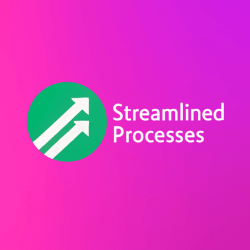For Business Process Management Optimization, see our main page here.
What Is Business Process Management Optimization?
Business Process Management Optimization is the ongoing effort to improve business performance by analyzing, refining, and aligning organizational processes. It targets efficiency, cost reduction, agility, and compliance across operations. The goal is not just to automate tasks, but to improve how work gets done overall.
Organizations today face increasing pressure to do more with less. As a result, improving workflows, decision-making, and resource allocation has become a priority across industries. Business Process Management Optimization provides a structured approach to achieve those outcomes.
Why Optimization Matters in Today’s Business Environment
In a fast-changing marketplace, static business processes become a liability. Outdated or poorly defined workflows lead to wasted time, duplicate tasks, and customer dissatisfaction. On the other hand, optimized processes support innovation, better customer experiences, and faster response to change.
For example, a mid-sized insurance company reduced policy approval time by 45% after implementing Business Process Management Optimization. They identified redundant steps in their underwriting process and used automated decisioning to speed things up.
Key Phases of Business Process Management Optimization
Optimization is typically carried out in phases. Each phase builds on the previous to create long-term impact. Here’s a simplified breakdown:
- Process Identification: Define and prioritize which business processes to improve.
- Process Analysis: Discover bottlenecks, delays, or waste through data and stakeholder input.
- Redesign or Reengineering: Develop new models that eliminate non-value activities and align with goals.
- Implementation: Apply changes through workflow tools, training, or automation platforms.
- Monitoring and Improvement: Measure progress, track KPIs, and adjust continuously.
Consequently, this structured approach ensures sustainable improvements rather than short-lived fixes.
Tools and Technologies Supporting Optimization
Many organizations use digital tools to aid Business Process Management Optimization. These tools help document processes, model changes, track KPIs, and even automate repetitive tasks. Some commonly used categories include:
- Process Mining Platforms: Reveal how processes actually run using system event logs (e.g., Celonis).
- BPM Suites: Provide modeling, automation, and integration features (e.g., Appian, Signavio).
- Low-Code Automation Tools: Let teams prototype new workflows quickly without heavy coding (e.g., Microsoft Power Automate, Nintex).
- AI & Machine Learning: Enable intelligent decision-making and predictive routing of tasks.
In short, technology makes complex optimization goals more achievable. However, it should be guided by clear strategy and human oversight.
Top Benefits of Business Process Management Optimization
Companies that consistently invest in optimization enjoy a range of benefits. These include:
- Higher Operational Efficiency: Streamlined workflows reduce cycle times and processing errors.
- Cost Savings: Eliminating wasteful processes directly impacts the bottom line.
- Stronger Agility: Responsive processes enable faster adaptation to changes in demand or regulation.
- Improved Collaboration: Clear responsibilities and transparency promote teamwork.
- Enhanced Customer Satisfaction: Efficient service delivery boosts brand loyalty and referrals.
In a 2023 survey by Deloitte, over 67% of executives said that process optimization helped them scale operations more effectively post-pandemic. That aligns with what we’ve observed across clients in healthcare, logistics, and government sectors.
Common Pitfalls to Avoid
While the benefits are clear, Business Process Management Optimization can fall short when mismanaged. Common challenges include:
- Ignoring Employee Input: Frontline employees often know where inefficiencies lie but are rarely consulted.
- Over-Automating: Not all processes benefit from automation—some need redesign before tech is applied.
- Neglecting Change Management: Without proper training and communication, staff may resist new processes.
- Lack of Ownership: Optimization efforts fail when there’s no clear accountability or leadership support.
Most importantly, teams should treat optimization as a culture, not a one-time event.
Industry Trends Driving Optimization Efforts
Several mega trends are pushing companies toward Business Process Management Optimization. These include:
- Remote Work Models: Organizations are rethinking processes for virtual collaboration and digital workflows.
- Regulatory Compliance: Industries like finance and healthcare must adapt quickly to new requirements.
- AI Integration: Natural language processing and predictive analytics deepen insight into process performance.
- Customer-Centric Models: Businesses must meet rising expectations around speed and personalization.
As a result, companies unable to adapt their processes often fall behind competitors who can.
Actionable Strategies for Getting Started
If you’re just beginning your optimization journey, start small and scale. Here are some starter strategies:
- Identify low-performing processes based on KPIs such as delays or rework.
- Use process mapping software to visualize each step and handoff clearly.
- Interview stakeholders to reveal hidden inefficiencies.
- Pilot optimizations in a controlled team, then expand based on learnings.
- Track metrics before and after to demonstrate ROI to leadership.
Likewise, setting up a cross-functional optimization team can create momentum and shared ownership of results.
FAQ: Business Process Management Optimization
What types of businesses benefit from process optimization?
All businesses benefit, but complex organizations with high-volume workflows gain the most. This includes sectors like insurance, healthcare, logistics, utilities, and manufacturing.
What’s the difference between BPM and BPM Optimization?
BPM refers to managing business processes, while optimization is the fine-tuning of these processes to make them better, faster, and more reliable. In other words, optimization is a deeper layer of process management.
How long does an optimization project take?
That depends on the process scope and resources. A departmental optimization might take 4–8 weeks. A company-wide initiative could span 6–12 months or longer.
Can Business Process Management Optimization reduce employee workload?
Yes. It removes repetitive tasks, clarifies roles, and often makes work more meaningful. However, it requires staff to adopt smarter tools and workflows.
How important is automation to this process?
Automation plays a key role, but it’s not the only discipline. Proper process understanding, redesign, and training are equally critical.
This article was created with the assistance of AI tools and reviewed by our team at Streamlined Processes LLC to ensure accuracy and relevance.
Follow us on Facebook here.

